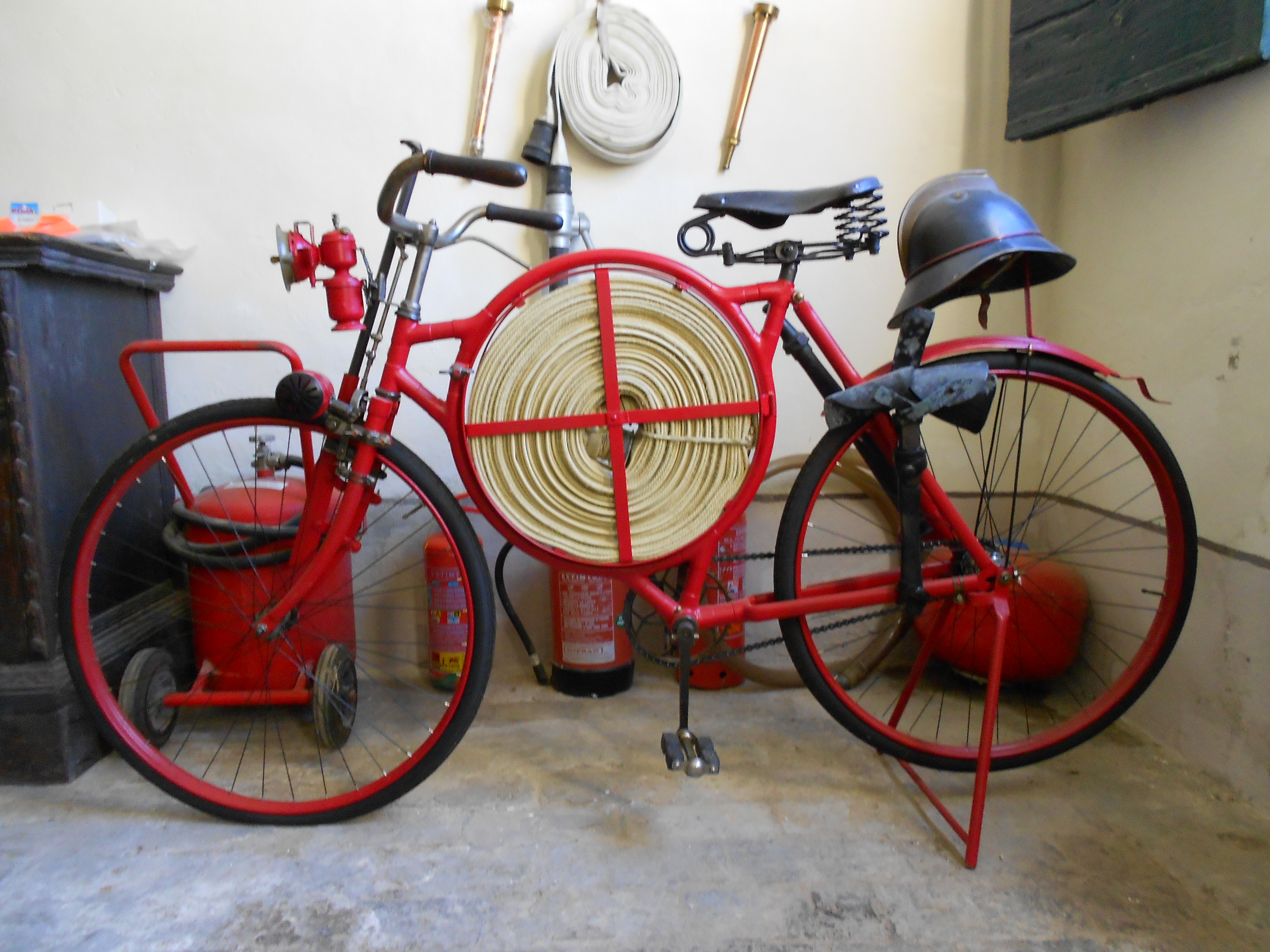|
Training Wheels
Training wheels, known as stabilizers outside North America, are a pair of additional wheels attached to the rear axle of a bicycle, effectively turning it into a quadricycle, for beginners learning to ride independently. Since the late 1990s, balance bikes have gradually replaced training wheels as a more effective tool for developing a sense of balance. History The American company Huffy introduced training wheels in 1949 with its 'Convertible' bike. The typical design for training wheels has not changed since this time. They are composed of two small wheels, one on each side of the rear wheel of the bicycle. They are attached laterally to a metal bracket or frame that extends outward from the bicycle frame, ideally keeping the training wheels just above the ground. The bracket is meant to be adjustable to accommodate different heights and angles of the training wheels, allowing for customization based on the rider's needs, but this is difficult to achieve in practice. The ... [...More Info...] [...Related Items...] OR: [Wikipedia] [Google] [Baidu] |
Bicycle
A bicycle, also called a pedal cycle, bike, push-bike or cycle, is a human-powered transport, human-powered or motorized bicycle, motor-assisted, bicycle pedal, pedal-driven, single-track vehicle, with two bicycle wheel, wheels attached to a bicycle frame, frame, one behind the other. A is called a cyclist, or bicyclist. Bicycles were introduced in the 19th century in Europe. By the early 21st century there were more than 1 billion bicycles. There are many more bicycles than cars. Bicycles are the principal Mode of transport, means of transport in many regions. They also provide a popular form of recreation, and have been adapted for use as Toy, children's toys. Bicycles are used for Physical fitness, fitness, Military bicycle, military and Police bicycle, police applications, Bicycle messenger, courier services, Cycle sport, bicycle racing, and artistic cycling. The basic shape and configuration of a typical Safety bicycle, upright or "safety" bicycle, has changed lit ... [...More Info...] [...Related Items...] OR: [Wikipedia] [Google] [Baidu] |
Quadracycle
A quadracycle (also spelled quadricycle) is a four-wheeled human-powered land vehicle. It is also referred to as a quadcycle, pedal car or four-wheeled bicycle amongst other terms. Quadracycles have been in use since 1853 and have grown into several families of vehicles for a variety of purposes, including tourist rentals, pedal taxis, private touring, mountain and industrial use. Nomenclature There is no consensus amongst manufacturers of four-wheeled, human-powered vehicles as to what this class of vehicles should be called, although ''quadracycle'' is the most commonly used term. Manufacturers who do refer to their products by class of vehicle call them: *Quadracycle - 11 manufacturers *Four-wheel bicycle - 7 manufacturers *Quadricycle - 5 manufacturers *Quadcycle - 3 manufacturers *Pedal car - 2 manufacturers *Quad - 2 manufacturers In addition there are single manufacturers who call them Go-kart, Car, Car-Bike, Ecological car, Human Powered Vehicle, Pedal Kart, Quadri ... [...More Info...] [...Related Items...] OR: [Wikipedia] [Google] [Baidu] |
Balance Bikes
A balance bike (or run bike) is a bicycle without bicycle pedal, pedals that learners propel by pushing their feet against the ground. By allowing children to focus on developing their sense of balance and coordination before introducing pedalling, balance bikes enable independent riding more quickly than training wheels. History Balance bikes descend from the earliest two-wheeled bicycle, a or dandy horse, invented by Karl Drais in 1817. These early balance bikes consisted of a simple wooden frame with two wheels and no pedals, and were designed for adult use. During the twentieth century, children typically learned to ride a bicycle with lateral training wheels. In 1997, German designer Rolf Mertens introduced the first commercially produced (running bike) under the brand KOKUA Bikes. Children's balance bikes quickly gained popularity in Europe in the 2000s and spread elsewhere in the world by the early 2010s. Balance bikes are now a common tool used to teach young children ... [...More Info...] [...Related Items...] OR: [Wikipedia] [Google] [Baidu] |
Sense Of Balance
The sense of balance or equilibrioception is the perception of balance (ability), balance and Orientation (geometry), spatial orientation. It helps prevent humans and nonhuman animals from falling over when standing or moving. Equilibrioception is the result of a number of sensory systems working together; the eyes (visual system), the inner ears (vestibular system), and the body's sense of where it is in space (proprioception) ideally need to be intact. The vestibular system, the region of the inner ear where three semicircular canals converge, works with the visual system to keep objects in focus when the head is moving. This is called the Vestibulo-ocular reflex, vestibulo-ocular reflex (VOR). The balance system works with the visual and skeletal systems (the muscles and joints and their sensors) to maintain orientation or balance. Visual signals sent to the brain about the body's position in relation to its surroundings are processed by the brain and compared to information ... [...More Info...] [...Related Items...] OR: [Wikipedia] [Google] [Baidu] |
Huffy
The Huffy Corporation is the largest U.S. market-share supplier of bicycles with its headquarters in Dayton, Ohio, Dayton, Ohio, United States. Early history It has its roots in 1887 when George Huffman, George P. Huffman purchased the Davis Sewing Machine Company and in 1890 moved its sewing machine factory from Watertown (city), New York, Watertown, New York, to Dayton, Ohio. The Davis Sewing Machine company made their first Dayton bicycle, in Dayton, Ohio, in 1892. In 1924, George's son, Horace M. Huffman Sr., founded the Huffman Manufacturing Company. From then until 1949, Huffman continued to manufacture and sell bicycles under the "Dayton" brand. During the 1930s, Huffman participated in the revival of the American cycling industry, during which Horace Huffman commented on a "change of attitude". Although Huffman dabbled in the high-end of the market, they never overcame their entry-level reputation. Post-war history In 1949, Huffman developed the Huffy Convertible, wh ... [...More Info...] [...Related Items...] OR: [Wikipedia] [Google] [Baidu] |
Software Development
Software development is the process of designing and Implementation, implementing a software solution to Computer user satisfaction, satisfy a User (computing), user. The process is more encompassing than Computer programming, programming, writing source code, code, in that it includes conceiving the goal, evaluating feasibility, analyzing software requirements, requirements, software design, design, software testing, testing and software release life cycle, release. The process is part of software engineering which also includes management, organizational management, Software project management, project management, configuration management and other aspects. Software development involves many skills and job specializations including software programmer, programming, software test, testing, Technical writing, documentation, graphic design, user support, marketing, and fundraising. Software development involves many software tools, tools including: compiler, integrated develo ... [...More Info...] [...Related Items...] OR: [Wikipedia] [Google] [Baidu] |
Countersteering
Countersteering is used by single-track vehicle operators, such as cyclists and motorcyclists, to initiate a turn toward a given direction by momentarily steering counter to the desired direction ("steer left to turn right"). To negotiate a turn successfully, the combined center of mass of the rider and the single-track vehicle must first be leaned in the direction of the turn, and steering briefly in the opposite direction causes that lean. The rider's action of countersteering is sometimes referred to as "giving a steering command". The scientific literature does not provide a clear and comprehensive definition of countersteering. In fact, "a proper distinction between steer torque and steer angle ... is not always made." How it works When countersteering to turn right, the following is performed: * A torque on the handlebars to the left is applied. * The front wheel will then rotate about the steering axis to the left and the tire will generate forces in the contact pat ... [...More Info...] [...Related Items...] OR: [Wikipedia] [Google] [Baidu] |
Dandy Horse
The dandy horse, an English nickname for what was first called a Laufmaschine ("running machine" in German), then a vélocipède or draisienne (in French and then English), and then a pedestrian curricle or hobby-horse, or swiftwalker, is a human-powered vehicle that, being the first means of transport to make use of the two-wheeler principle, is regarded as the first bicycle. The dandy horse is a foot-propelled vehicle, powered by the rider's feet on the ground instead of the pedals of later bicycles. It was invented by Karl Drais (who called it a ''Laufmaschine'' "running machine" in 1817, and then patented by him in France in February 1818 using the term ''vélocipède''. It is also known as a ''Draisine'' ( in German, a term used in English only for light auxiliary railcars regardless of their form of propulsion), and as a ''draisienne'' ( in French and English. In English, it is also sometimes still known as a velocipede, but that term now also has a broader meaning. H ... [...More Info...] [...Related Items...] OR: [Wikipedia] [Google] [Baidu] |
Bicycle Wheels
A bicycle, also called a pedal cycle, bike, push-bike or cycle, is a human-powered or motor-assisted, pedal-driven, single-track vehicle, with two wheels attached to a frame, one behind the other. A is called a cyclist, or bicyclist. Bicycles were introduced in the 19th century in Europe. By the early 21st century there were more than 1 billion bicycles. There are many more bicycles than cars. Bicycles are the principal means of transport in many regions. They also provide a popular form of recreation, and have been adapted for use as children's toys. Bicycles are used for fitness, military and police applications, courier services, bicycle racing, and artistic cycling. The basic shape and configuration of a typical upright or "safety" bicycle, has changed little since the first chain-driven model was developed around 1885. However, many details have been improved, especially since the advent of modern materials and computer-aided design. These have allowed for ... [...More Info...] [...Related Items...] OR: [Wikipedia] [Google] [Baidu] |
Cycling Equipment
Cycling, also known as bicycling or biking, is the activity of riding a bicycle or other types of pedal-driven human-powered vehicles such as balance bikes, unicycles, tricycles, and quadricycles. Cycling is practised around the world for purposes including transport, recreation, exercise, and competitive sport. History Cycling became popularized in Europe and North America in the latter part and especially the last decade of the 19th century. Today, over 50 percent of the human population knows how to ride a bike. War The bicycle has been used as a method of reconnaissance as well as transporting soldiers and supplies to combat zones. In this it has taken over many of the functions of horses in warfare. In the Second Boer War, both sides used bicycles for scouting. In World War I, France, Germany, Australia and New Zealand used bicycles to move troops. In its 1937 invasion of China, Japan employed some 50,000 bicycle troops, and similar forces were instrumental in Japan' ... [...More Info...] [...Related Items...] OR: [Wikipedia] [Google] [Baidu] |






